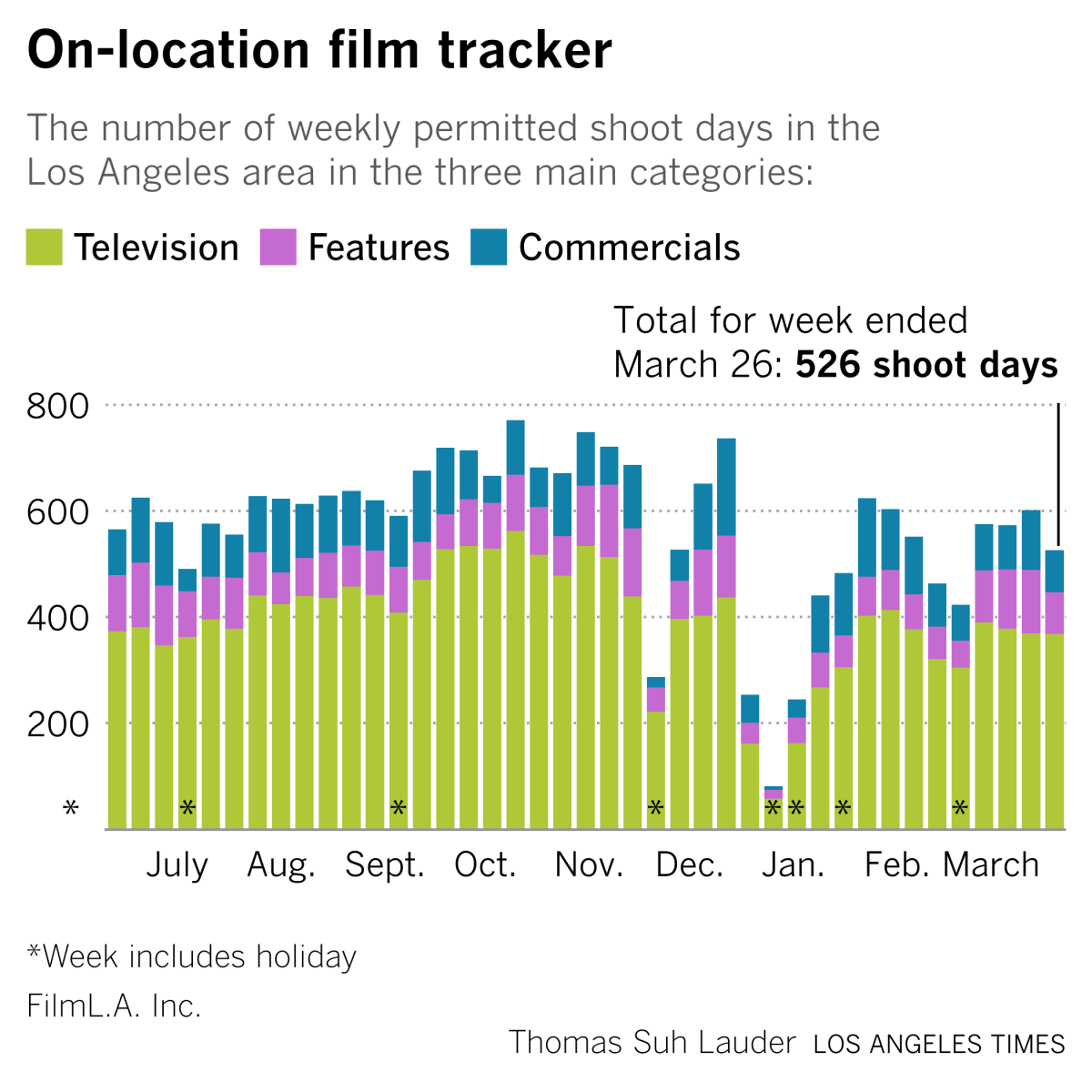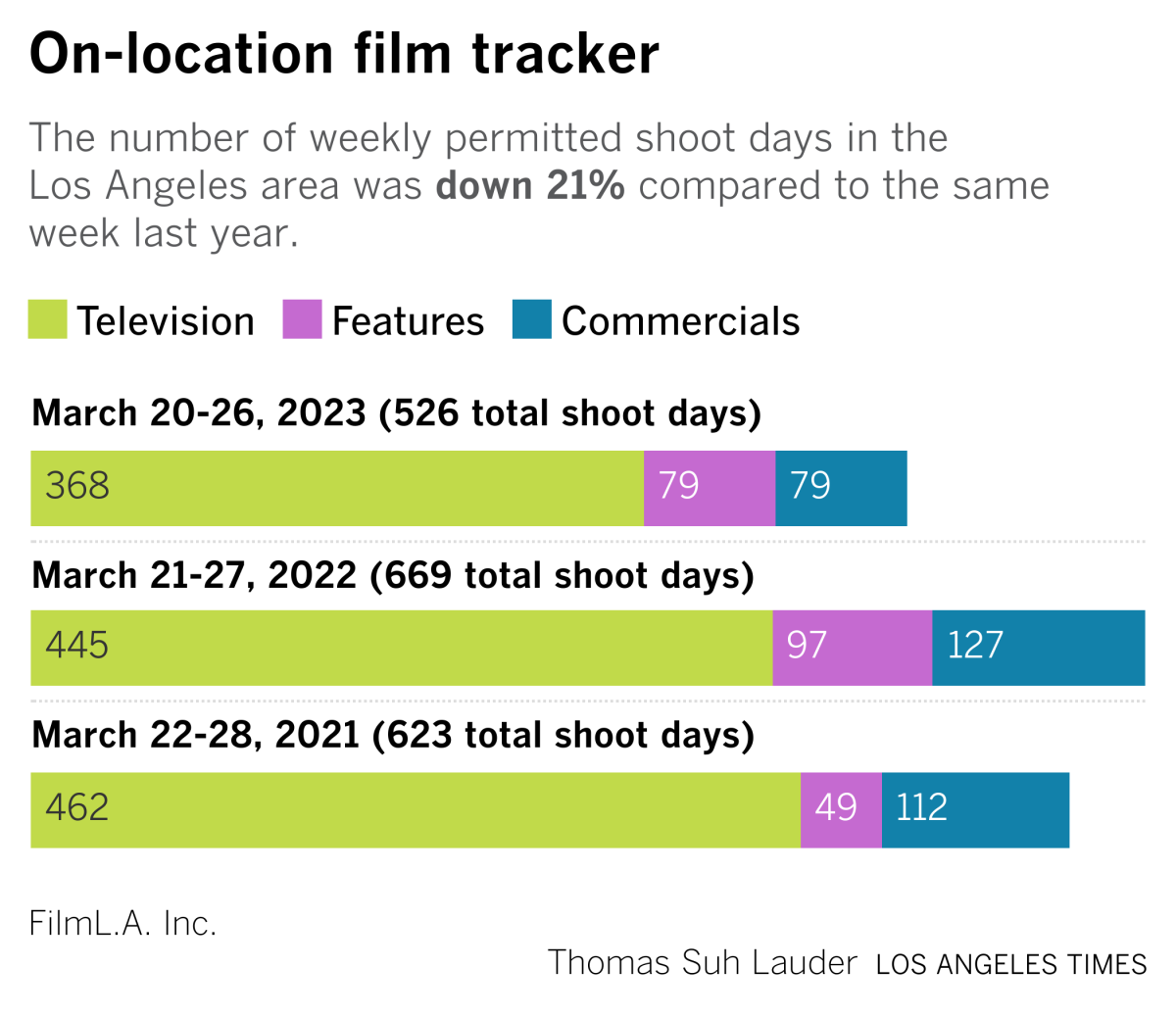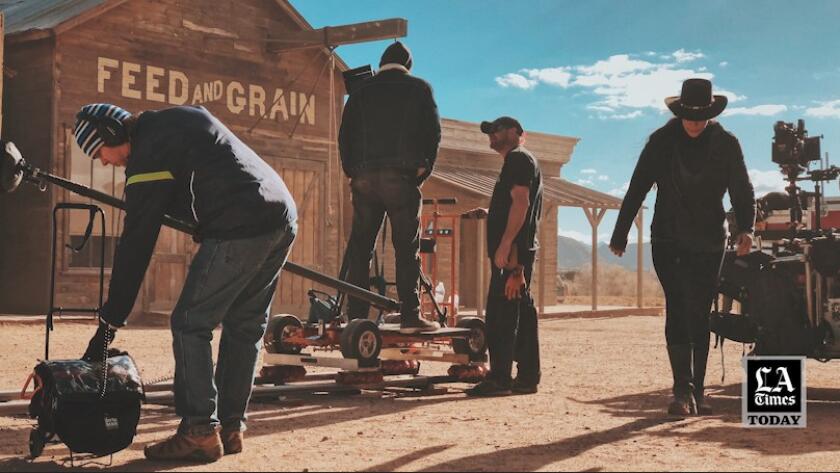Why Hollywood isn’t - and can’t be - just about blockbusters

- Share via
Welcome to the Wide Shot, a newsletter about the business of entertainment. Sign up here to get it in your inbox.
Studio executives like to talk about the good old days when companies would release a lot of mid-budget titles at the box office — your adult comedies, your mid-tier erotic thrillers, your star-studded rom-coms.
This isn’t just nostalgia.
Mid-priced movies helped drive consistent business. Having a diverse slate of new movies in theaters week after week helped make moviegoing a habit for audiences when they wanted to do something with friends or go out on a date.
The last couple months at the box office have shown why it’s important for Hollywood to release movies of all sizes and types, not just the $200-million action spectacles and tiny horror flicks that have come to dominate theater screens.
Lionsgate’s “John Wick: Chapter 4,” a $100-million action sequel that opened with $73.5 million at the domestic box office, is no one’s idea of a mid-budget movie. Neither is MGM’s “Creed III,” really, having cost a reported $75 million to make. But both of these franchises originated from films with relatively modest costs.
The film industry needs to take risks on mid-level films — generally defined by having budgets of $20 million to $80 million — in order to create new intellectual property and bring out audiences that aren’t interested in the ongoing superhero universes.
But the business lately hasn’t been set up to regularly produce these kinds of movies at the rate it used to, at least not for movie theaters.
For a time, the industry seemed to abandon many of the practices that made midsized films economically viable, like having multiple release windows (theatrical, home video, television) that allowed movies to make money and exist in the public consciousness for a long time.
Streaming’s business prioritizes volume in order to attract subscribers, with each film backed by a short marketing push, if any at all. That makes it difficult for any individual film to have a serious imprint.
“We have completely gotten out of that mindset of how to provide a regular cadence of cost-efficient movies, so that you have that thing that gives legs to everything else,” said indie producer and former Amazon Studios film executive Ted Hope. “And with that, is also the decimation of the things that gave something a kind of evergreen status.”
Some of the most disruptive streaming-era practices are starting to go away. Studios are returning to traditional, albeit shorter, windows. Tech giants Apple and Amazon are both embracing traditional theatrical releases, Bloomberg recently reported.
But for now, Hollywood’s business remains very much barbell-shaped.
There’s heavy concentration of business going toward giant studio movies on one side — with escalating budgets and multidimensional world-building stakes — and a head-spinning number of tiny productions on the other, leaving a thin middle market of movies.
The top 10 movies accounted for 55% of the domestic box office last year, compared with the average of 36% from 2015 to 2019, wrote Cowen & Co. analyst Doug Creutz in a report issued Sunday. Looking at budgets, just 14 movies released in theaters in 2022 cost more than $100 million, but took up 55% of U.S.-Canada ticket sales.
That doesn’t make it impossible to make money with mid-budget films. “Cocaine Bear” and “80 for Brady” succeeded by targeting specific audiences with killer marketing hooks. But the more prestigious adult-oriented fare, the kind that Hope bet on while at Amazon, is as challenging as it’s ever been.
We’ve talked before about the struggles of prestigious mid-range movies that typically get Oscars consideration, like “Tár” and “The Fabelmans.”
As a result of the box office difficulties and the financial struggles of streamers, distributors have gotten more gun-shy at the same time that Netflix and Apple have bid up expectations for what an indie film can fetch at the market.
A major Sundance title, “Eileen,” which has some serious star power and was based on a popular novel, only recently got picked up by Neon.
Just as Hollywood needs mid-budget movies to create new franchises, the business needs a strong indie market to develop new talent.
So I was fascinated by a recent story in Esquire about the culture of “no budget” indie films, where new filmmakers are taking a punk-rock, do-it-yourself approach to filmmaking and distribution. In many ways, they’re abiding by the “14 Commandments” of no-budget writing and production that Hope and James Schamus created some 30 years ago.
This is enabled by the lower cost of the minimum equipment required to make a movie, and the ease with which filmmakers can put their material on the web.
The piece, by journalist and filmmaker Max Cea, cites as examples “Jethica,” a “superb $10K stalker-ghost movie” released on Fandor, and Jess Zeidman’s $120,000 queer coming-of-age drama “Tahara.” Some filmmakers have managed to get mainstream acclaim and commercial attention for their minimalist movies, including “Skinamarink” and “We’re All Going to the World’s Fair.”
This kind of thing has been happening for a long time, and mirrors the effects of the digital revolution on the music industry, where easy online distribution led to a surge of music being released outside the traditional distribution system.
University of Minnesota professors recently published a paper analyzing film budgets from 2000 to 2016, and found that movies with budgets between $100,000 and $5 million jumped by about 350%.
“Digitization has meant a whole new distribution channel that makes it possible for entirely different kinds of products to get creative and find markets,” said University of Minnesota business professor Joel Waldfogel.
Some of these microbudget movies can make their money back. But mostly, this part of the business seems aimed at reclaiming some of the rebellious spirit that characterized the independent filmmaking of the late ‘80s and early ‘90s, before the film festival circuit became overtly commercial and flooded with big-ticket streaming deals.
“It’s harder for those challenging films like, god forbid, you make a political movie, and you have a festival play it — like something without stars and a new voice that challenges the status quo — it’s never been harder for that,” Hope said. “But I believe as a result, you’ll see things change. You will have new things emerge and the powerful will stumble.”
Stuff we wrote
— Disney layoffs begin this week. Disney CEO Bob Iger announced in February that the company would shed 7,000 jobs after losing billions on streaming.
— ViacomCBS and the NAACP formed a landmark pact. Why their TV shows are nowhere to be found.
— How ‘Vanderpump Rules’ cheating scandal turned this lawyer into a meme. The popularity of the show has soared on the back of a cheating scandal, generating unexpected fame for one entertainment attorney.
— Lindsay Lohan, Jake Paul, Lil Yachty, other celebs hit with SEC charges for boosting crypto. The SEC announces charges against a host of celebrities for promoting crypto as an investment without disclosing that they were paid to do so.
— Tucker Carlson producer’s discrimination claims go beyond Dominion scandal. The 79-page lawsuit, filed in federal court in New York, raises questions about whether Fox News has sufficiently modernized its workplace culture since co-founder Roger Ailes was forced out in 2016.
— Newsom wants to give Hollywood a big new perk. Will lawmakers agree? Gov. Newsom’s proposal to make California’s film tax credit refundable is a leverage point for lawmakers who want to see greater diversity in Hollywood.
— ICYMI. Automated writing? Not so fast, says the Writers Guild of America. Alec Baldwin questions prosecutor’s conduct in ‘Rust’ case. Newsmax returns to DirecTV after nasty dispute, censorship claims.
Film shoots
Latest film and television production data from FilmLA.


Best of the web
— Global music revenue growth slowed in 2022, but still rose 9% to $26.2 billion. (Variety)
— The FBI raided a notable journalist’s home. Rolling Stone didn’t tell readers why. (NPR)
— Inside the downfall of Vice. (Insider)
— Why do people care that Sofia Coppola’s daughter was grounded? (New York Times)
— Vince McMahon reimburses WWE $17.4 million for costs related to sexual misconduct investigation. (Variety)
— The Gwyneth Paltrow ski cash trial produces a spectacularly awkward video.
Finally ...
Taking the helm of the Essential California newsletter, Gustavo Arellano celebrates the 100-year anniversary of Harold Lloyd’s “Safety Last.” Time flies when you’re hanging on to a clock for dear life.
- Share via
Watch L.A. Times Today at 7 p.m. on Spectrum News 1 on Channel 1 or live stream on the Spectrum News App. Palos Verdes Peninsula and Orange County viewers can watch on Cox Systems on channel 99.
The Wide Shot is going to Sundance!
We’re sending daily dispatches from Park City throughout the festival’s first weekend. Sign up here for all things Sundance, plus a regular diet of news, analysis and insights on the business of Hollywood, from streaming wars to production.
You may occasionally receive promotional content from the Los Angeles Times.





